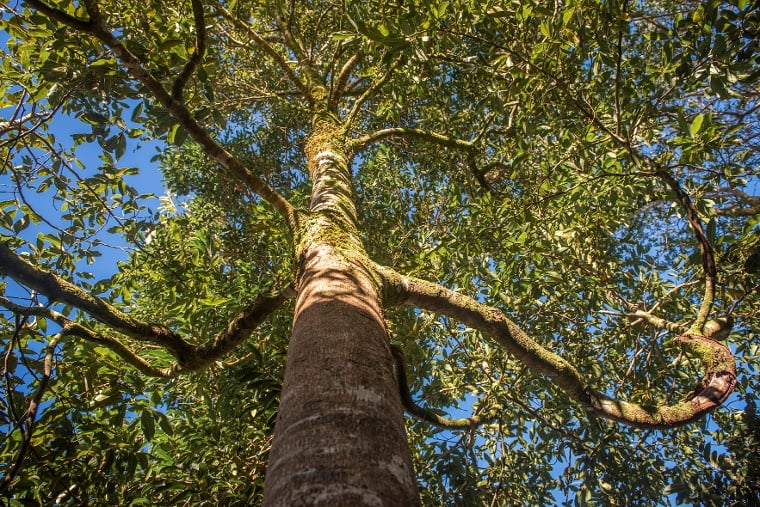The Ocotea Tree and the Birds That Need It

The Ocotea Tree. Ocotea Trees are a type of tree in the family of the Lauraceae. In Monteverde there are several species, however, some of the most important of them are also the most delicate and important for conservation efforts, especially the endemic Ocotea Monteverdensis.
When we think about the Monteverde Cloud Forest, what comes to mind are pristine habitats, enormous trees, and the bright drizzle that flies in the strong winds. The weird call of the bellbird, the casual sight of a black guan looking big on a high branch. The magical quetzal bird moving like, yes, a feathered serpent upon the canopy.
They all eat from a beautiful tree that is endemic to the area. A very rare gift of the cloud forests for dozens of species of birds like the one I just mentioned and many more.
It is also a very endangered species that the entire community is working hard to restore.
Let’s talk a little about it.
The Science of the Ocotea Tree
The Ocotea Monteverdensis is also called “quizarra blanco” or “quizarra amarillo.”
It’s part of the Lauraceae family, also known as the avocado family. There are hundreds of Lauraceae throughout the world, and just in Costa Rica we have over 100 species.
Many species are found in cloud forests and other wet mountain forests, with over 70 species reported in Monteverde.
Species in this family, like the avocado we eat, have fruit with a single seed and a soft, fleshy rind that many birds and mammals like eating. While some species produce fruit as large as the cultivated avocado available in markets, a lot of them bear a much smaller fruit than that, that can be around an inch to an inch and a half in length.
The Ocotea fruit, like many aguacatillos, is held in a red cupola to make it more visible to birds.

The leaves of the Ocotea tree are rather long and slender, a lustrous dark green and the stems are rusty red and very hairy.
Locally recognized as “aguacatillos” or “little avocados,” the Ocotea tree is reported to be eaten by roughly ten bird species, all of which have large enough gorges to swallow the fruits (with seeds) whole.
Where can we see them?
Actually, if you are staying with us at Ocotea Boutique Hotel, you will have one right outside our reception area.

However, to talk more broadly, you can find them at a very specific altitude, between 1200 and 1500 m elevation, in a 2-km-wide band. You can also find it on the Pacific side of the mountain range.
This is where most of the people in the Monteverde zone live, which caused some problems decades ago. This natural band was heavily deforested in the decades of the 1940s and 1950s, and the tree has a slow time reproducing naturally.
Out of a study made by Dev Joslin in the Monteverde Institute and with aerial pictures from Giancarlo Pucci, the researchers found around 779 Ocotea Monteverdensis specimens left in Monteverde, thus, the planet.
But there’s reason for hope!
Mi Ocotea Project, A Local Effort
The Mi Ocotea Project is an idea created by various organizations of the region to support the recovery of this relevant species of our forests.
Its goals are to protect the existing Ocoteas, grow new trees and create a genuine community effort in the region's people to take ownership and protect the trees for future generations.
Ocoteas have been classified as “critically endangered” by the International Union for the Conservation of Nature because of their small range, specific habitat needs, and tiny population (IUCN), so Mi Ocotea has some bold goals.
The Mi Ocotea project objectives are:
-
To discover, protect, and encourage the areas where natural regeneration will be found, as well as to create consciousness among landowners about the importance of keeping the trees safe.
-
Increase the population and area where it lives by planting 5000 seedlings and 8,000 seedlings of other trees in the right habitat, as well as encouraging Ocoteas to grow naturally.
-
To raise public awareness through educational programs, pamphlets, and signs in public places.
-
To keep on researching the best ways to regenerate.
It’s a bold project, but one that we need!
The Birds of Monteverde and the Ocotea Tree
Seed Spreading and the Bellbird
Research has found that Ocoteas only provide plentiful fruit every three years, resulting in a specific pattern of bird concentration around areas where they are. Other years, the birds migrate to different parts of the zone, as other fruit trees attract them during such years.
Of course, fruit-bearing trees and fruit-eating birds have a mutually beneficial relationship. The latter receive free sustenance, while the former have their seeds dispersed across the environment. However, the quality of this “seed-spreading” is not always consistent.
In this way, the bellbird and Ocoteas appear to share a particular relationship.
Research by Dan Wenny and Doug Levy discovered the different ways that the seeds of various bird species that ate this fruit were disseminated. Toucans, guans, quetzals, mountain robins, and other birds all scattered their seeds near the adult fruiting tree on which they were feasting (within 20 m).
However, Bellbirds would go to their “perching branch” to complete digesting their fruit and regurgitate their seeds, spreading them away from the original Ocotea tree they ate from and into areas that are usually more open to the water and sun, giving them a much higher rate to survive and thrive.
The Ocotea and the Oilbirds
A bird native to South America is also observed in the mountains of Monteverde, and is known as the guacharo or oilbird.
Between 2009 and 2010, guides and bird lovers spotted some individuals of the guacharo, the first recorded sightings in decades. This bird is reddish-brown with white spots on the nape of the neck and wings, and a beautiful sight that was worth noting!
The arrival of this bird to Monteverde is a mystery. Previously, the oilbird could only be seen in Trinidad and Tobago, Venezuela, Colombia, Ecuador, Peru, Bolivia, and Brazil. But all of a sudden, it began appearing in Monteverde!
This rare bird sleeps during the day and flies at night. To do so, it uses echo localization like bats, so as not to collide with trees and to be able to collect fruits. Hard enough to spot anyway!
But, you can find them in the Monteverde Cloud Forest and Curi-Cancha Preserve when the Ocotea trees are fruiting. The oilbird perches near the tree and then flies to collect up to six seeds, and then perches again.
The Resplendent Quetzal and the Ocotea Trees
Resplendent Quetzals (Pharomachrus Mocinno) are commonly referred to as “specialist” fruit-eating birds, although there is a lot of research to be made about the range of their diet or the features of the fruits they choose.
Quetzals feed on a minimum of 12-18 kinds of fruits most of the year in the lower montane forests of Monteverde, Costa Rica, reaching up to a yearly total of at least 41 species.
Although they eat the watery, small-seeded berries of many second-growth plants, and they also feed on tiny insects and even lizards, they primarily eat the fruits of approximately 18 species in the laurel family (Lauraceae), including the Ocotea tree!
For this reason, the Ocotea habitat distributions appear to determine the time and direction of seasonal movements by quetzals.
It’s pretty amazing actually! Nestling quetzals are given complete fruits as early as the second day after hatching. And adults spend significantly less time delivering fruits to nestlings than delivering insects or lizards, owing to the relative ease of “catching” ripe fruits (as opposed to animal prey) during the mating season.
In fact, the anatomy, location, behavior, and life history of quetzals show mutual dependence and, possibly, general coevolution with the Llauraceous trees whose seeds they disperse.
For this reason, several Central American highland reserves have safeguarded populations of quetzals, and these biological corridors have to establish routes for the Quetzals, so that they’re not isolated when one or another tree is not bearing fruit.
When You Come to Monteverde
Nowadays in the schools and organizations in Monteverde, we are raising awareness about the Ocotea Monteverdensis and other similar species for the community to protect and encourage them in their properties and forests. The more specimens we have, the better the chances are for these species to survive and support the other birds, bats, and insects that need them.
When you plan your hiking trip in the Monteverde forests, ask Ocotea Tours and Transfers to take you where you will see these magnificent trees and the birds that live around them.
Maybe you can even plant some!




